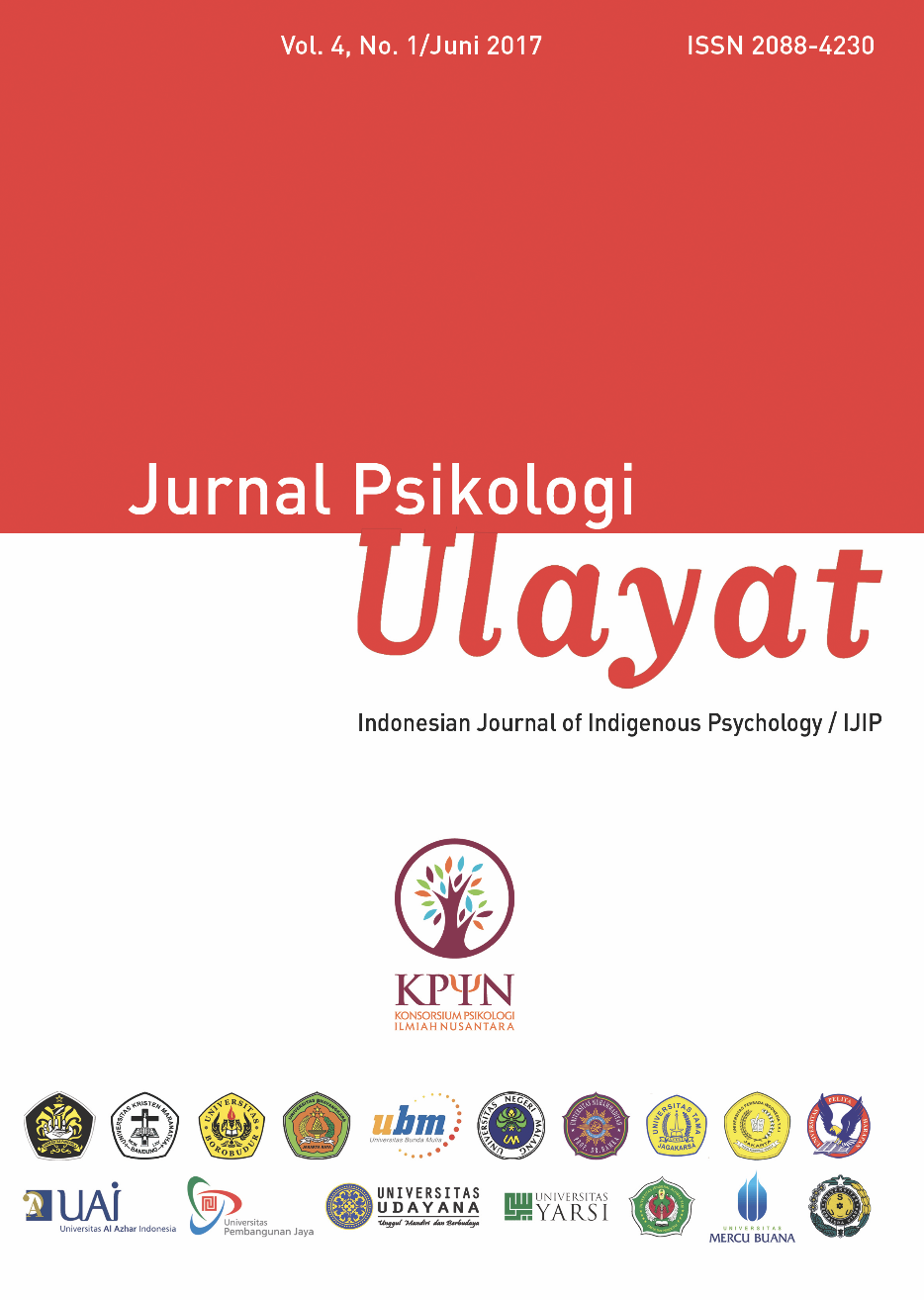The role of social support in mitigating dating violence: A correlational study of adolescence in Jakarta
 https://doi.org/10.24854/jpu57
https://doi.org/10.24854/jpu57
Keywords:
social support, dating violence, adolescenceAbstract
The present study aims to examine the influence of social supports (i.e. family, friends, and significant others) on dating violence in adolescents. The measuring instruments used were Multidimential Scale of Perceived Social Support and Conflict Adolescent Dating Relationship Inventory. In the present study 400 adolescents participated with the age range of 15 to 18 years old, whereas 305 (76.3%) are female and 95 (23.8%) are male. The result from regression analysis revealed that family support is important in preventing dating violence in adolescent. On the contrary, social support from friends and significant others do not contribute in preventing dating violence. Result, limitation, and suggestion are discussed.
Downloads
References
Canthy-Mitchell, J., & Zimet, G. D. (2000) Psychometric Properties of multidimensional scale of perceived social support in urban adolescents. American Journal of community psychology, 28 (3), 391-400. doi: 10.1023/A: 1005109522457
Cohen, S., & Wills, T. A. (1985). Stress, social support and the buffering hypothesis. Psychological Bulletin, 98, 310-357.
Dariyo, A. (2004). Psikologi perkembangan remaja. Bogor: Ghalia Indonesia.
Davis, A. (2008). Interpersonal and Physical Dating Violence among Teens. Views from the National Council on Crime and Delinquency. Ditemu kembali dari http://www.nccdglobal.org/sites/ default/files/publication_pdf/focus-dating-violence.pdf
Jang, S. A., Sung, M. J., Park, Y. J., & Jeon, T. W. (2016). Copycat suicide induced by entertainment celebrity suicides in South Korea. Korean Neuropsychiatric Association, 13(1), 74-81. doi: http:// dx.doi.org/10.4306/pi.2016.13.1.74
Kinsfogel, K. M., Grych, J. H. (2004). Interparental conflict and adolescent dating relationships: Integrating cognitive, emotional, and peer influences. Journal of Family Psychology, 18(3), 505-515.
Lamm, T. N. (2010). Examining dating violence in adolescent relationships and prevention program options for educators (Tesis tidak dipublikasikan). University of Wisconsin-Stout, Amerika Serikat.
Leadbeater, B. J., Banister, E. M., Ellis, W. E., & Yeung, R. (2008). Victimization and relational aggression in adolescent romantic relationships: The influence of parental and peer behaviors, and individual adjustment. Journal Youth Adolescence, 37, 359-372. doi: 10.1007/s10964-007-9269-0
Murray, J. (2001). But I love him; protecting your teen daughter from controlling, abusive dating relationships. New York, NY: Harper Collins.
Nelson, D. A., & Crick, N. R. (2002). Parental psychological control: Implications for childhood physical and relational aggression. In B. K. Barber (Ed.), Intrusive parenting: How psychological control affects children and adolescents (pp. 161-189). Washington, DC: American Psychological Association.
Nurrakhmi, M, & Astuti, Y. D. (2008). Hubungan antara kepribadian ekstrovert dengan kecenderungan melakukan kekerasan dalam pacaran. Universitas Islam Indonesia Yogyakarta. Ditemu kembali dari http://psychology.uii.ac.id/images/stories/jadwal_kuliah/naskah-publikasi-04320166.pdf
Ogden, J. (2007). Health psychology: A textbook (4th ed.). New York, NY: McGraw-Hill.
Payne, K. L., Ward, T., Miller, A., & Vasquez, K. (2013). Teen Dating Violence: A Resource and Prevention Toolkit. Alverno College Research Center for Women and Girls. Retrived from: https://www.alverno.edu/media/alvernocollege/rcwg/pdfs/TeenDatingToolkit.pdf
Richards, T. N., & Branch, K. A., (2012). The relationship between social support and adolescent dating violence: A comparison across genders. Journal of Interpersonal violence. 27(8), 1540-1561. doi: 10.1177/0886260511425796
Richards, T. N., Branch, K. A., & Ray, K. (2014). The impact of parental and peer social support on dating violence perpetration and victimization among female adolescents: A longitudinal study. Violence and Victims, 29(2), 317-331
Sarafino, E. P., & Smith, T. W. (2002). Health psychology biopsychosocial interaction (4th Ed.). New York, NY: John Wiley & Sons.
Sarwono, S. W. (2005). Teori-teori psikologi sosial. Jakarta, Indonesia: PT Raja Grafindo Persada.
Schiff, M., & Zeira, A. (2005). Dating violence and sexual risk behaviors in a sample of at-risk Israeli youth. Child Abuse & Neglect,29, 1249-1263.
Stewart, B. T. (2010). The moderating effect of perceived positive peer norms on the relationship between age, gender, acceptance of violence, and perpetration of teen relationship violence (Tesis tidak dipublikasikan). San Diego State University, Amerika Serikat.
Wall, A. (2009). Relationship violence: Risk factors for adolescents. Journal of Undergraduate Research at Minnesota State University, 9(17), ditemu kembali dari http://cornerstone.lib.mnsu.edu/jur/ vol9/iss1/17
Windle, M., & Mrug, S. (2008). Cross-gender violence perpetration and victimization among early adolescents and associations with attitudes toward dating conflict. Journal Youth Adolescence, 38, 429-439. doi: 10.1007/s10964-008-9328-1.
Wolfe, D. A., Wekerle, C., Scott, K., Straatman, A., Grasley, C., & Reitzel-Jaffe, D. (2001). Development and validation of the conflict in adolescent dating relationships inventory. Psychological Assessment, 13(2), 277-293.
Zimet, G. D., Dahlem, N. W., Zimet, S. G., & Farley, G. K. (1998). The multidimensional scale of perceived social support. Journal of Personality Assessment, 52, 30-41.
Downloads
Published
How to Cite
Issue
Section
Citation Check
License
Copyright (c) 2017 Administrator JPU; Ainul Mardiah, Dwi Puspita Satriana, Elida Syahriati

This work is licensed under a Creative Commons Attribution 4.0 International License.
The authors agree to the following terms:
- Authors retain copyright and grant the journal the right of first publication with the work simultaneously licensed under a Creative Commons Attribution License that allows others to share the work with an acknowledgement of the work's authorship and initial publication in this journal.
- Authors are permitted and encouraged to post their work online (e.g., in institutional repositories or on their website) for the exposure of their work with an acknowledgement of Jurnal Psikologi Ulayat: Indonesian Journal of Indigenous Psychology (JPU) as an outlet of their published work.
![]()
This work is licensed under a Creative Commons Attribution 4.0 International License.

 Ainul Mardiah
Ainul Mardiah
 Faculty of Psychology, Universitas Mercu Buana, Indonesia
Faculty of Psychology, Universitas Mercu Buana, Indonesia

